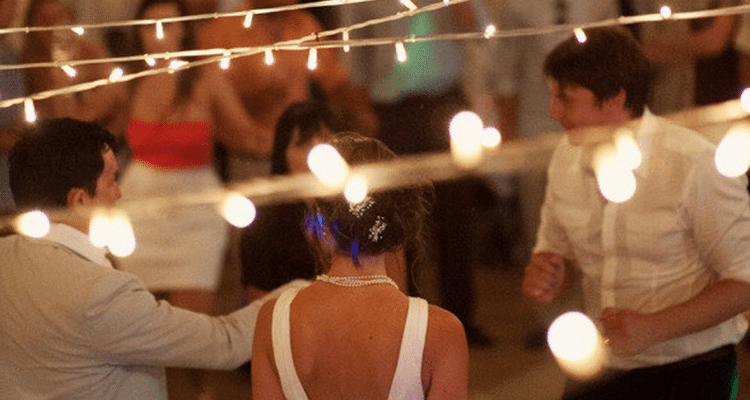Typically, a wedding reception follows a standard format— one that includes plenty of stages to keep track of. Here are the common elements you’ll typically find at a wedding, with a brief description of each.
Guests Arrive at the Reception Site
Some guests arrive early at the reception. So be sure all reception to-dos are complete by the time your wedding’s scheduled to start. Also, all wedding vendors should be suited up in proper attire for early and lingering guests. All tables should be set up, including the cake table, the entertainment’s table, the sign-in table, food tables, and tables with chairs for all guests. If you have a seating arrangement, all seating lists should be at the reception with everyone’s name indicating where they sit.
Introducing the Wedding Party
This step isn’t mandatory, but it’s nice for everyone to know who the wedding party — many guests haven’t met them before your wedding. Create a “Reception Planning Guide,” and give this to your emcee before the wedding. Among other things, this guide should detail your party by the order they enter the reception site, and give their names and titles. The order of entrance is: parents of the bride, parents of the groom, ushers with bridesmaids, flower girl and ring bearer, special guests, best man, maid/matron of honor, bride and groom. In addition, go over how to pronounce the wedding party’s names with the emcee.
Introducing the Bride and Groom
This is always the last of the introductions. Everyone should stand before the bride and groom enter. In addition, you can arrange a special song with the musical entertainment and a special announcement with the emcee to punctuate a truly grand entrance. Also, inform the emcee how you’d like to be introduced: Mr. and Mrs. Smith? John and Jane Doe?
Giving the Blessing
This is another step that’s not mandatory — but for the religious couple, it makes a nice setting. If you invite the minister to the reception, ask them to conduct the blessing. But if they’re not able to attend, a parent or family friend is a good idea. Alternately, the emcee could bless the meal. Be sure to communicate with whoever’s giving the blessing well in advance, so they’re prepared to give it a personal touch.
Forks at the Ready!
It’s time to eat! And no matter how many people are clamoring to wish you well, the bride and groom should stop, rest and partake. This may be your only chance in the day that can all-too-easily become one big blur. Plus, it’s customary for the bride and groom to start the food line, which most guests are aware of — so don’t be late!
Cutting the Cake
Of course, the bride and groom traditionally cut the first slice on their wedding cake. Then, the bride feeds half of the piece of cake to the groom, and the groom feeds the remainder to the bride. The ceremonial cutting is meant to symbolize the couple’s caring and sharing for one another. Don’t be afraid to use forks for this step, since they look great in pictures. They almost minimize the possibility of smearing cake all over the wedding regalia.
Toasting the Happy Couple
In the first stage of toasting, the bride and groom toast each other, then interlock arms and drink. Immediately following, the best man and maid/matron of honor make toasts to the bridal couple. Be prepared for other family and friends to follow, too.
Bride & Groom’s First Dance
The Bride & Groom’s Dance is the first dance between a bride and groom as a married couple. Where you choose to place this in the schedule depends on your preferences. One common option: immediately following the grand entrance, with the wedding party circling the dance.
Father & Daughter’s Dance
The Father & Daughter’s Dance or the Father Bride Dance is the dance between the father(s) of the bride and the bride. Brides, if you have more than one father in your life, one can tap the other on the shoulder in the middle of the dance so you can dance with both of them. If you don’t have a father, a common substitute is a father figure. Even your brother would make a very nice gesture.
Mother & Groom’s Dance
The Mother & Groom’s dance is the dance between the mother(s) of the groom and the groom. Grooms, if you have more than one mother in your life, one can tap the other on the shoulder in the middle of the dance so you can dance with both. If you don’t have a mother, a common substitute is a mother figure, or your sister.
Special Dances
Like many people, you might have some songs that are near and dear to your heart. You can ask the entertainment to play them immediately after the formal dances. Example: If someone close to you passed recently, you could ask the entertainment to play “Angels Among Us” by Alabama.
Bouquet and Garter Toss
In the traditional tossing of the bouquet, the bride tosses her bouquet (or a substitute) to all the single women in attendance. Immediately after the tossing, a chair is set in the middle of the dance floor, for the bride to sit on while the groom removes the garter from her leg, and tosses it to all the single men in attendance. The man and woman who catches the garter and bouquet are said to be the next to marry.
Dancing and Fun
This is what you pay the music entertainment to do — get people out of their chairs and on to the dance floor. Give the entertainment your favorite songs and some absolute no-gos, but don’t try to conscript them to a list of 100 songs you picked out in advance.


